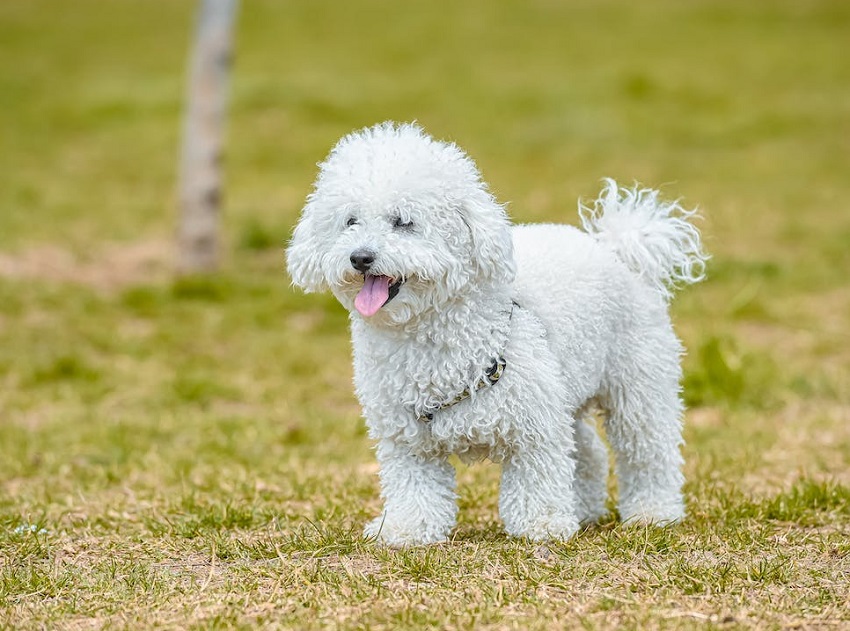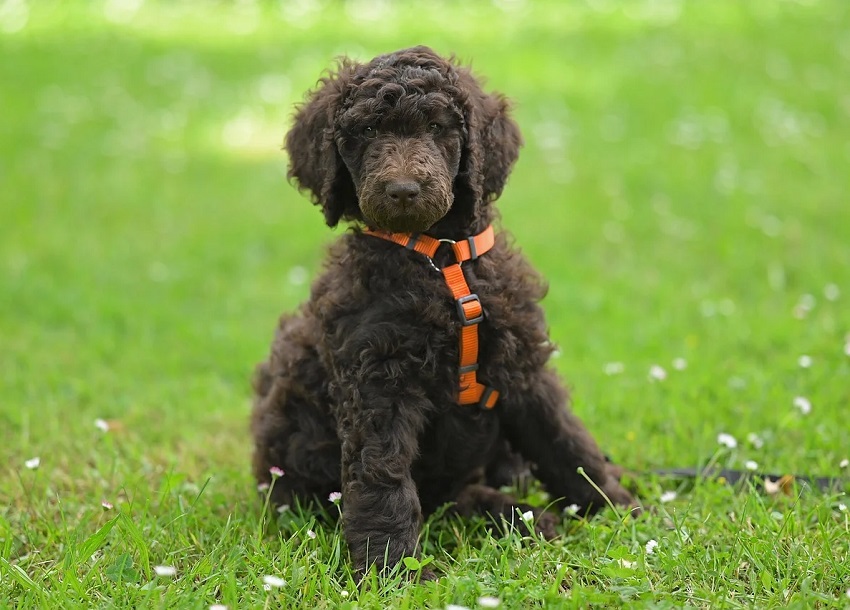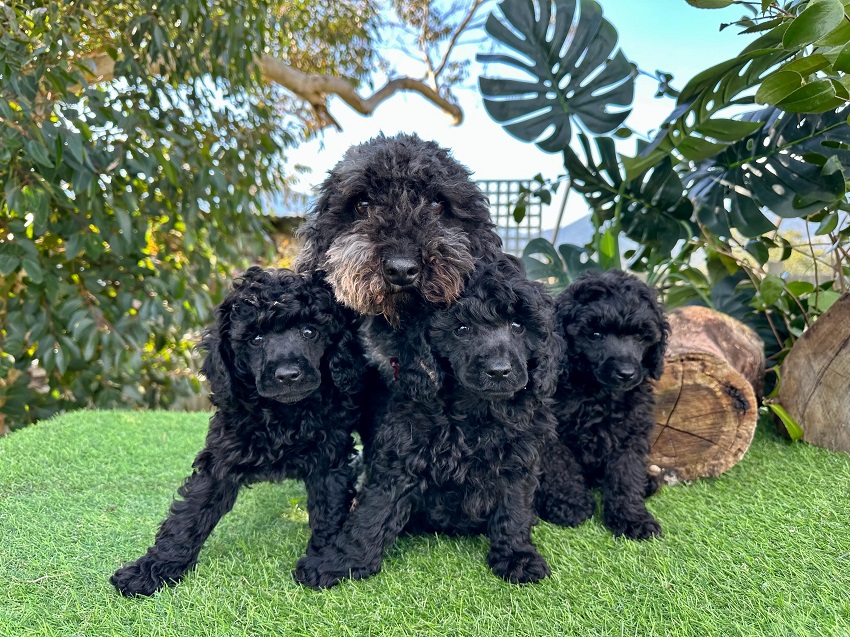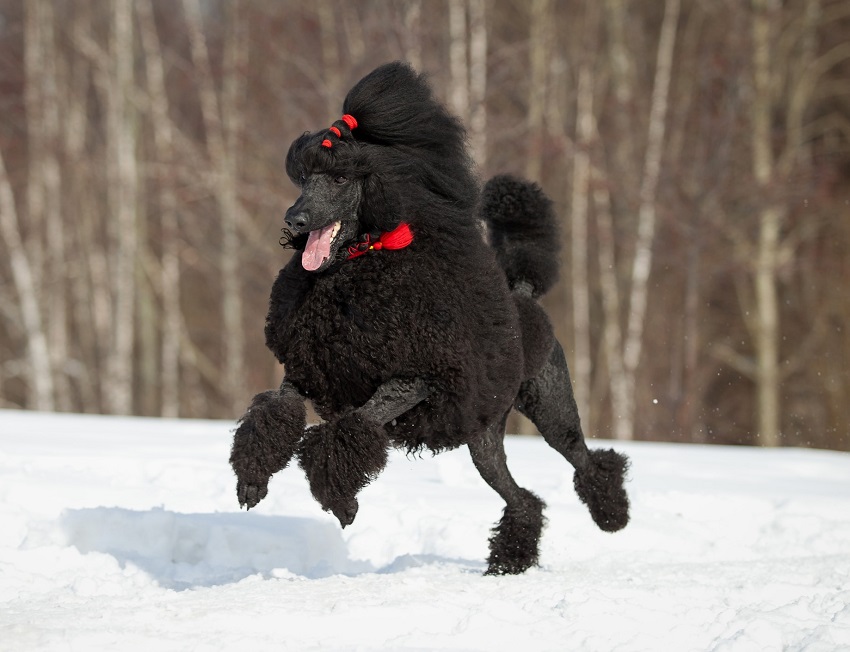Beyond their sophisticated looks and signature curly coats, Poodles are celebrated as one of the most intelligent dog breeds in the world. From their history as skilled water retrievers to their role as loyal companions, Poodles consistently impress owners with their quick wit and trainability. Join Know All Animals as we explore the fascinating journey and hidden secrets behind this charming and elegant breed!
Poodle Breed at a Glance
Today’s Poodles, with their stylish and often intricate grooming, exude an aristocratic air. However, their history tells a different story. They were originally bred for the demanding job of retrieving game from the water. It’s hard to believe these refined and beautiful dogs were once rugged hunters. Today, the Poodle is an ideal choice for families looking for an intelligent, affectionate, and relatively low-shedding dog.
- Origin: Poodles trace their roots to Germany and France.
- Size: They come in a variety of sizes: Standard, Moyen (Medium), Miniature, Toy (Tiny), and Teacup.
- Lifespan: The average lifespan is 10-18 years.
- Coat: Their coat is curly, dense, and low-shedding, making them a great choice for people with allergies. They come in a wide range of colors, including black, white, cream, apricot, red, gray, chocolate, and parti-colored (bi-color).
- Temperament: Poodles are known for being intelligent, energetic, and friendly with both children and other pets. They are highly trainable and eager to please their owners.
- Exercise Needs: They have moderate to high energy levels and thrive in active households.
- Grooming: Their coat requires frequent brushing to prevent matting and professional grooming every month or so.
- Other Names: They are also known as Caniche (French), Pudel (German), and often called “duck hunters” or “sleeve dogs.”

1. The Origin of the Poodle
The Poodle is believed to have originated in Germany, although it was later developed and popularized in France. Some theories suggest the Poodle is the result of crossbreeding between various European water dogs, such as the French, German, and Spanish water dogs, possibly with roots tracing back to the North African Barbet breed.
Poodles were originally bred to be water retrievers, trained to dive into cold water to retrieve waterfowl for hunters. The name “Poodle” comes from the Old German word “pudelin” or “pudel,” which means “to splash in the water.” In France, where the breed flourished, they were called “Caniche,” meaning “duck dog.”
The Poodle’s iconic haircut isn’t just for show—it serves a practical purpose. The shaving of the coat made it lighter and prevented it from freezing or getting tangled in brush while the dogs swam. The tufts of hair left on the joints and other vital areas provided protection from the cold water.
Global Recognition and Development:
- 1874: The first Poodle was registered by the Kennel Club in the UK.
- 1886: The American Kennel Club (AKC) officially recognized the Poodle breed.
- 1950s–1970s: The Poodle became the most popular dog breed in the U.S. due to its charming looks and intelligence.
- 2021-2023: Poodles consistently ranked among the top 5 most popular dog breeds based on new AKC registrations.
2. Poodle Appearance
The Poodle is famous for its distinctive curly coat and elegant, well-proportioned body, with a length that is nearly equal to its height at the shoulder.
- Size: Poodles come in a range of sizes, with an average height of 24-60 cm and a weight of 3-32 kg.
- Head: They have a slightly rounded skull and a long, straight muzzle, though some lines have shorter muzzles.
- Eyes: The eyes are dark brown or black and set far apart.
- Ears: The ears are large, long, and hang close to the head, covered in wavy hair.
- Paws: Their feet are small and have firm pads.
- Coat: The Poodle’s tight, curly coat is its defining feature. Colors include black, blue, silver, gray, cream, apricot, red, white, brown, and cafe au lait. Unlike many other breeds, a Poodle’s hair continuously grows and does not shed on its own.

3. Poodle Temperament
3.1. Intelligent and Loyal
Poodles consistently rank as one of the most intelligent dog breeds worldwide. They have an impressive ability to focus and quickly grasp new commands, making them much easier to train than most other breeds.
They are also intensely loyal to their owners. Poodles form strong bonds with their human family and thrive on affection, always eager to be petted and to play with their owners.
3.2. Energetic and Mischievous
Poodles are active and playful dogs that need daily exercise. If they are confined indoors for too long without enough physical activity, they can become irritable and develop destructive behaviors, such as chewing on furniture or barking excessively.
For this reason, it’s recommended to spend one to two hours per day walking or playing with your Poodle. Remember, their mischievous nature is a sign of their energy, so early and consistent training is key to preventing bad habits.
3.3. Friendly and Sociable
Poodles are known for their friendly, cheerful, and sociable personalities. They get along particularly well with children and love to play with them. However, they can be protective and will often growl and bark to alert you if a stranger enters the house.
4. Classifying Poodles
Poodles are categorized into four main types based on their size:
- Toy Poodle: Known for their elegant, sophisticated appearance, Toy Poodles are the smallest of the Poodle family. They stand up to 28 cm (11 inches) tall and weigh between 3-4 kg (6-9 lbs). Their petite size makes them ideal as a companion pet. They have curly coats that come in various colors, including black, blue, silver, gray, cream, red, white, brown, or café-au-lait. They have a straight tail held high, small but long legs, and webbed toes. Their head is small and long, and their strong, slightly arched neck leads to long, flat ears that hang close to their head.
- Miniature Poodle: Miniatures have a balanced body and a short, small tail. They stand between 28-38 cm (11-15 inches) tall and weigh around 7-8 kg (15-18 lbs). Their skull is a medium size, with a long, straight muzzle. Their oval-shaped eyes are dark brown or black, and their ears drop down on either side of their face.
- Standard Poodle: This is the largest Poodle variety, with a height of 45-60 cm (18-24 inches) or more and a weight of 20-32 kg (45-70 lbs). Standard Poodles have a square-shaped body, with their back and two legs forming equal sides. Their four legs stand straight, forming a right angle with their body and the ground.
- Teacup Poodle: This is the smallest Poodle type. The Teacup Poodle originated in the United States in the 19th century as a result of a genetic mutation from crossbreeding Poodles.
5. Caring for a Poodle
Poodles are relatively easy to care for, with simple needs for food and basic grooming. They also adapt well to new environments.
5.1. Living Environment
Poodles can live in various environments, from rural to urban settings. Since they are small, they can get enough exercise even in a small space, as long as they have room to play.
A key thing to remember when caring for a Poodle is that they don’t handle extreme temperatures well, whether too hot or too cold. Ensure their living space is cool, clean, and well-ventilated to help them thrive. In winter, to prevent respiratory illnesses, limit their time outdoors or use sweaters to keep them warm.
Because of their energetic nature, you should take your Poodle on a 15-30 minute walk every day. They also enjoy gentle play and light sports, but avoid overly strenuous activities that could harm their health.
5.2. Poodle Diet
A Poodle’s diet doesn’t need to be complicated, but it must be nutritionally balanced. Their dietary needs will change as they grow, so you should adjust their food accordingly.
2 Months Old
At this stage, Poodles are transitioning from mother’s milk and have a delicate digestive system. Feed them:
- Thin porridge cooked in bone broth.
- Dry food that has been softened with water.
- 200-300 ml of warm milk daily.
- Mashed vegetables. Never feed them bones or hard foods.
3-6 Months Old
Your puppy is more accustomed to solid food now, but you should still not overfeed it. Give them 3-4 meals a day with food like:
- Porridge with chicken, pork, beef, or organ meat.
- Mashed vegetables.
- 300-400 ml of warm milk daily.
- Again, never give them bones or hard foods.
6+ Months Old
By this age, Poodles are adults with stable digestive systems. Provide them with a balanced diet of carbohydrates, fiber, protein, and vitamins 2-3 times a day. Their meals can include:
- Homemade food from beef, chicken, or pork, along with vegetables.
- High-quality dry kibble, supplemented with eggs, vitamins, minerals, and treats.
5.3. Grooming Your Poodle
Poodles don’t tolerate cold well, so be careful when grooming them to prevent them from getting sick.
- Use warm water for baths.
- Use a special dog shampoo.
- Immediately dry their coat completely after bathing.
- Bathe them twice a week in the summer but less often in the winter.
- Brush their coat daily to prevent matting and maintain its fluffiness.
- Have a professional grooming session once a month.
- Regularly clean their teeth, ears, and paws to prevent health problems.
5.4. Training Your Poodle
Training a Poodle to be obedient requires treats and a leash. Be patient and consistent, and begin training as soon as you bring your puppy home to establish good habits.
After your puppy gets used to its new home, you can begin training it to walk around the house. Use a leash and guide it through different rooms, but avoid taking it to off-limits areas. The first place you should take them is their eating area. Let them have a small snack, but don’t let them get too excited. Then, lead them to other areas.
A key rule to remember: You walk first. Make them wait, and then let them enter a room after you. This establishes that you are the leader and that they have your permission to enter. Use the leash throughout the process to maintain control.

6. Common Poodle Health Problems
Although Poodles are generally healthy dogs, they are susceptible to a few common health issues.
6.1. Acute Enteritis (Gastroenteritis)
This is an inflammation of the intestines that, if caught early, can be treated effectively. It’s important to take your Poodle to the vet as soon as you notice any unusual symptoms, such as diarrhea, vomiting, or lethargy.
Prevention: To help prevent enteritis, you should adjust their diet, regularly clean their food and water bowls, and avoid giving them raw eggs or spoiled food. Also, be sure to keep their vaccinations up to date.
6.2. Canine Distemper (Care Disease)
The distemper virus can progress very quickly once it infects a dog. If you suspect your Poodle has distemper, you must take it to a vet immediately for professional treatment and a prescribed plan.
Prevention: The most effective way to prevent this disease is through vaccination. A proper diet that boosts your dog’s immune system is also essential for prevention.
6.3. Dermatitis (Skin Inflammation)
Poodles have thick, dense coats that can be difficult to keep clean. This coat can become a breeding ground for bacteria and parasites like fleas and ticks. These parasites feed on your dog’s blood, reproduce quickly, and can cause painful sores. If left untreated, this can lead to fungal infections, mange, and severe dermatitis.
Prevention: Regular bathing and grooming are crucial. If you notice any skin issues, a vet can provide the best course of treatment.
7. How Much Does a Poodle Cost?
The price of a Poodle varies based on its size and coat color. Here is a general price guide for different Poodle varieties:
- Miniature and Standard Poodles: These larger Poodles generally cost between $158 and $554 USD.
Tiny Poodles:
- Common colors like red, cream, black, chocolate, and white are priced at approximately $229 to $305 USD.
- Gray-colored Tiny Poodles are more expensive, ranging from $344 to $382 USD.
Toy Poodles:
- For common colors such as chocolate, cream, red, black, and white, the price is typically $191 to $268 USD.
- Gray Toy Poodles are priced higher, at around $363 to $401 USD.
Teacup Poodles:
- Teacup Poodles in colors like red, chocolate, cream, white, and black cost approximately $303 to $379 USD.
- The price for a gray Teacup Poodle is significantly higher, ranging from $683 to $758 USD.

8. FAQ
Are Poodles hypoallergenic dogs?
Yes, Poodles are considered hypoallergenic because they have a curly coat that traps dander and doesn’t shed much. However, no dog is 100% allergy-free, so it’s best to spend time with a Poodle before bringing one home.
How often should I groom my Poodle?
Poodles require regular grooming, usually every 4–6 weeks, to keep their coat clean, free of mats, and healthy. Daily brushing is also recommended, especially for longer hairstyles.
Are Poodles good with children and other pets?
Yes, Poodles are intelligent, friendly, and social dogs. They usually get along well with children and other pets when properly socialized from a young age.
Poodles are intelligent, affectionate, and charming companions that are a great fit for many families. When you decide to bring a Poodle into your home, be sure to choose a reputable breeder and provide the proper care to ensure you have a healthy, happy dog by your side for years to come.
References: https://en.wikipedia.org/wiki/Poodle



